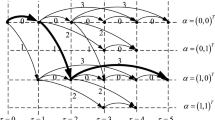Abstract
As many enterprises deal with orders of various products everyday and attend to maximize total profit or minimize total cost, a quick automatic dispatching tool is required for higher efficiency. In practical, the dispatching is not an easy task even for experienced experts; it is often determined depending on empirical knowledge, but usually would not be the optimal solution. It is due to the complex nature of the so-called “multi-plant order allocation problem”, which can be modeled as a typical mixed-integer programming problem. Considering companies with multiple plants, the large quantity of orders need to be distributed within a short time and the due dates of various orders shall be met such that the total costs can be minimized. In this research, an order allocation scheme for multi-plant to produce a variety of products is developed. The objective is to minimize total cost, including operation cost, setup cost, transportation cost, and the penalty cost of order delay under the constraint of capacity load. A mixed-integer programming model, named model of quasi-transportation problem, is proposed and solved. Several examples are presented and solved and compared by a general software LINDO and a genetic algorithm. Proposed genetic algorithm is demonstrated to be more efficient as the dimension of problem increases.
Similar content being viewed by others
References
Antonio L, Lorena N, Narciso MG (1996) Relaxation heuristics for a generalized assignment problem. Eur J Oper Res 91:600–610
Azuma O, Mitsuo G, Mitsumasa S (2006) Integrated data structure and scheduling approach for manufacturing and transportation using hybrid genetic algorithm. J Intell Manuf 17(4):411–421
Chan FTS (2006) Application of genetic algorithms with dominant genes in a distributed scheduling problem in flexible manufacturing systems. Int J Prod Res 44(3):523–543
Chen KJ, Ji P (2007) Development of a genetic algorithm for scheduling products with a multi-level structure. Int J Adv Manuf Technol 33(11–12):1229–1236
Cherbaks NS, Meller RD (2008) Modeling multiple plant sourcing decisions. Int J Prod Res 46(18):5165–5190
Defersha FM, Chen MY (2008) A parallel multiple Markov chain simulated annealing for multi-period manufacturing cell formation problems. Int J Adv Manuf Technol 37(1–2):140–156
Garey M, Johnson D (1979) Computers and intractability: A guide to the theory of NP-completeness. WH Freeman, New York
Gavish B, Pirkul H (1991) Algorithms for the multi-resource generalized assignment problem. Manage Sci 37(6):695–713
Gopal C, Cypress H (1993) Integrated distribution management:competing on customer service, time and cost. Irwin, Homewood
Hinterding R (1994) Mapping, order-independent genes and the knapsack problem. Proceedings of the First IEEE Conference on Evolutionary Computation. IEEE Press, Piscataway, pp 13–17
Holland JH (1992) Adaptation in natural and artificial systems. University of Michigan Press, Ann Arbor, Re-issued by MIT Press
Jawahar N, Aravindan P, Ponnambalam SG (1998) A genetic algorithm for scheduling flexible manufacturing systems. Int J Adv Manuf Technol 14(8):588–607
Kubota N, Fukuda T (1998) Schema representation in virus-evolutionary genetic algorithm for knapsack problem. Proceedings of the IEEE International Conference on Evolutionary Computation. IEEE Press, Piscataway, pp 834–838
LeBlanc LJ, Avraham S, Anandalinagm G (1999) Formulating and solving production planning problems. Eur J Oper Res 112:54–80
Martello S, Toth P (1990) Knapsack problems: algorithms and computer implementations. Wiley, Chichester, West Sussex, England
Nishimura E, Imai A, Papadimitriou S (2001) Berth allocation planning in the public berth system by genetic algorithms. Eur J Oper Res 131:282–292
Qi JG, Burns GR, Harrison DK (2000) The application of parallel multipopulation genetic algorithms to dynamic job-shop scheduling. Int J Adv Manuf Technol 16(8):609–615
Shadan AM, William GS (1995) Impact of ABC information on product mix and costing decisions. IEEE Trans Eng Manage 42(2):171–176
Vignaux GA, Michalewicz Z (1991) A genetic algorithm for the linear transportation problem. IEEE Trans Syst Man Cybern 21(3):445–452
Yang KK, Sum CC (1994) A comparison of job shop dispatching rules total cost criterion. Int J Prod Res 32(4):807–820
Author information
Authors and Affiliations
Corresponding author
Rights and permissions
About this article
Cite this article
Yang, FC., Chen, K., Wang, MT. et al. Mathematical modeling of multi-plant order allocation problem and solving by genetic algorithm with matrix representation. Int J Adv Manuf Technol 51, 1251–1259 (2010). https://doi.org/10.1007/s00170-010-2696-1
Received:
Accepted:
Published:
Issue Date:
DOI: https://doi.org/10.1007/s00170-010-2696-1




